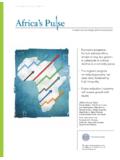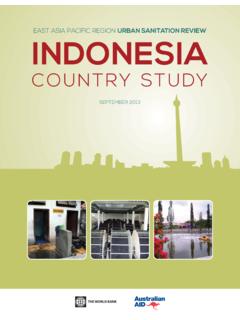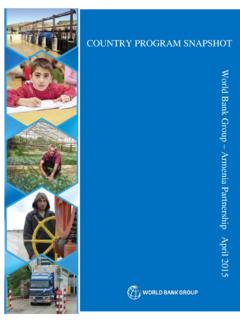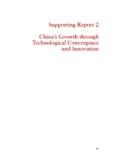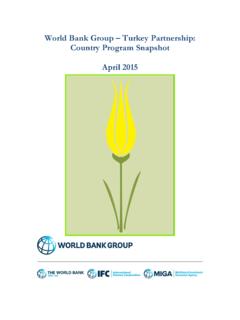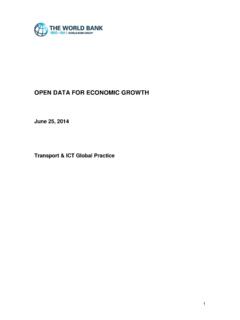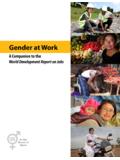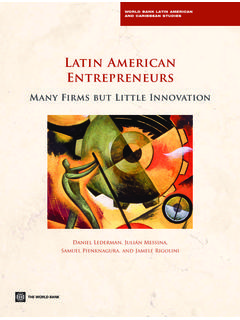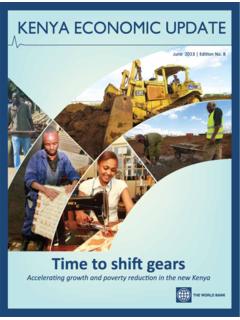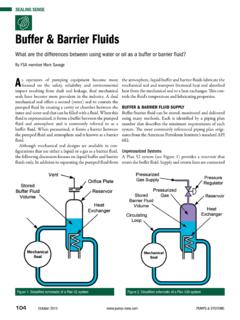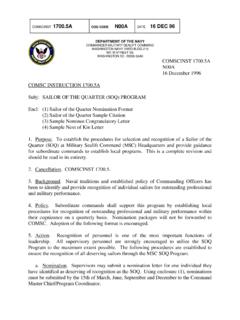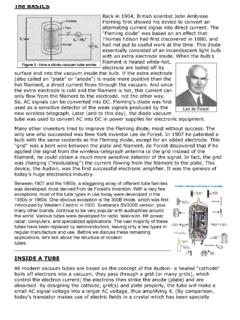Transcription of PNG Economic Briefing - World Bank
1 Papua New Guinea Economic Briefing From the last days of the boom to lasting improvements in living standards THE World bank GROUP IN PAPUA NEW GUINEA 2013 1 In 2012 PNG s economy enjoyed what it is likely to be the last year of strong growth for most sectors of PNG s economy in this Economic cycle. Construction of PNG-LNG and various spin-off investments, and broader investments in the domestic service sectors, continued to be key drivers. External conditions detracted from the economy, although they also helped to slow growth in prices. The government s 2013 budget represents a marked change from recent years, with the largest deficit on record aside from the 2009 global Economic crisis, substantially more funds allocated to lower-level administrative units, and markedly slower revenue growth expected.
2 While this budget may be affordable in the short-term, an extended series of deficits of this size risk returning PNG to the macroeconomic instability that followed its last extended Economic boom, as the government has acknowledged. The government expects to bring the budget back to balance by the 2017 elections through stronger revenue growth and plans to slow spending. Many of these plans appear ambitious, and may create tensions with the government s development goals. By capping the government s debt ratios, the new medium-term debt strategy anchors these fiscal targets. But there are significant risks around these projections, and around the effectiveness of spending as far more funds are allocated to less developed areas of PNG s public financial management systems.
3 Improving this will be key to addressing PNG s significant human development needs, documented in the recently-released 2009-2010 PNG Household Income & Expenditure Survey. Over coming years, growth across the economy is likely to slow significantly, beyond the large impact on headline growth rates of first production from the PNG-LNG project. In this environment, the foundations for PNG s next boom will lie in ensuring government policies effectively and efficiently help Papua New Guinea s emerging entrepreneurs do business. 1. Economic Update: The economy continued to expand strongly through 2012, although the drivers are receding and growth will slow through the coming years Strong and broad Economic growth continued in 2012, although the drivers of this strength started to recede PNG s economy continued to expand strongly through the first half of 2012, albeit less quickly than in 2010 and 2011.
4 Over 2012, the economy is likely to have grown by around 8 percent, compared with near 9 percent growth in 2011. Domestic demand remained the key driver, with pre-election spending of government funds augmenting the effects of ongoing construction of the PNG-LNG project and spin-off investments. Indeed, the strength in PNG s non-tradable sectors (largely domestic services) has accelerated the economy ahead of its Pacific neighbors. (Figure 1, Figure 2) Since early 2012, external factors have detracted from the domestic strength. The appreciation of the Kina (PGK) in 2011 and early 2012 and weakening international commodity prices into the second half of 2012 had the effects of both reducing rural production, incomes and government receipts, while also slowing the growth in urban consumer prices.
5 Treasury Department estimates suggest the key drivers of growth remained construction of the PNG-LNG project and activity across other domestic Construction of PNG-LNG and of the various spin-off investments remained the key drivers of PNG s Economic growth into the second half of 2012. While the official national accounts published by the PNG National Statistics Office have not been updated since 2006, the Treasury Department estimates that construction activity grew by almost one-quarter in 2012, to be double the level recorded as recently as 2009. Growth in wholesale & retail trade, and transport & communications activity in 2012 was only a little less rapid than construction, following several years of very strong growth.
6 All these sectors have been benefiting from the one-off surge in demand associated with the PNG-LNG project, which will end as construction winds down in 2013 and 2014. But there also appears to be a positive effect from this demand that is boosting Papua New Guinean firms physical and organizational capacity, and some of this boost in capacity will be beneficial for sustaining activity beyond the PNG-LNG project..and looser fiscal policy in The first half of 2012 was also notable for the deteriorating fiscal position and stimulus to domestic consumption, as government funds were spent ahead of the mid-year elections.. P A P U A N E W G U I N E A E C O N O M I C B R I E F I N G : 2 0 1 3 1 2 Government spending in the first half was faster than usual, with 40 percent of the 2012 appropriation spent by the end of June, or 25 percent more than was disbursed in the first six months of 2011.
7 Sixty percent of the recurrent budget had been released, while near one-third of the development budget was spent by mid-year. (Figure 11, Figure 12) Meanwhile revenues were weaker than the government had expected. Forecasts made in the third quarter were for tax receipts in 2012 to be PGK 354 million (5 percent) below budget. The deterioration was due to weaker mining and petroleum taxes and dividends, in part reflecting over-optimistic projections for commodity prices in the 2012 budget. Gold prices in 2012 were US$ 200 per ounce lower than the budget forecasts, and copper prices US$ 1000 / tonne lower. This added to the impact of volumes of both being significantly lower than expected. On the other hand, oil prices were US$ 10 per barrel higher and production 700,000 barrel greater than expected.
8 Figure 1: PNG has out-paced its Pacific neighbors since 2005, due to expanding activity in non-tradable sectors (cumulative real output growth and contributions, 1998-2004 and 2005-2011, percent and percentage points) Sources: World Development Indicators and World bank staff calculations ..while new public spending also made a notable contribution to domestic demand The difference between the above-budget spending and below-budget revenues was funded through domestic debt issuance, especially short-term (6 to 12 month) Treasury bonds and by drawing down the government s cash reserves. The central government s net claims on the central bank fell by PGK billion between December 2011 and June 2012, although about 15 percent of this draw-down of the government s holdings at the central bank appears to have shifted to commercial banks.
9 At the same time, deposits in trust accounts, ear-marked for future spending on defined projects (and held at both BPNG and commercial banks), fell by PGK 732 million in the first six months of 2012. About one-third of this movement is attributable to the first payments of the government s new tuition fee subsidy program (pre-funded through the 2011 Supplementary Budget). (Figure 3) Meanwhile, weaker external conditions and the stronger exchange rate became a drag on the economy The flow-through from deteriorating external conditions contrasts with the strength of the domestic economy. Copra, cocoa and coffee farmers and exporters all saw their incomes compressed by the falls in international prices through the first half of 2012, exacerbating the impact of the appreciation of the PGK in 2011.
10 Domestic factors, such as the shut-down of processing mills and supply chain issues, further reduced opportunities for domestic farmers. They responded by producing less, amplifying the negative impact of lower Kina prices on rural incomes. Copra and coffee farmers production appears to be particularly responsive to changes in prices, and to have become more so in recent years. (Figure 4) ..and lower production across PNG s mines was only offset by the start of production at the Ramu Nickel/Cobalt mine later in the year Wetter-than-usual weather, infrastructure problems and resource depletion hampered minerals and oil & gas production, especially in the first half of the year. However, Treasury still estimates output volumes rose by percent in 2012, following percent decline over 2011.

